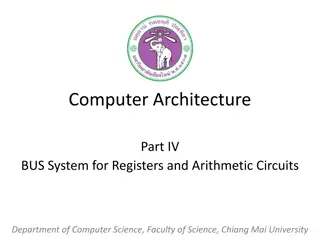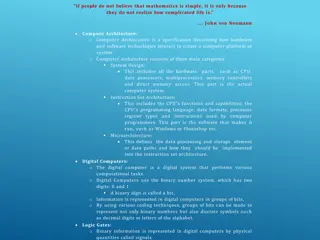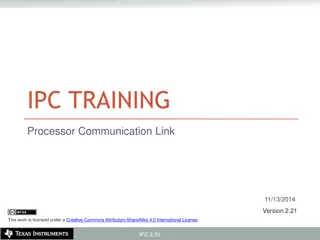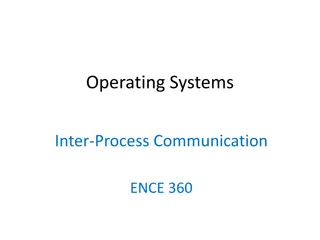Understanding Inter-Process Communication in Computer Architecture
Explore the key concepts of Inter-Process Communication (IPC) in computer architecture, covering topics such as signals, message queues, shared memory, and handling signals. Learn how to send and handle signals, manage never-ending programs, and control processes using utilities like kill. Dive into the different types of processes, interactive vs. background, and understand how to change process types effectively.
Download Presentation

Please find below an Image/Link to download the presentation.
The content on the website is provided AS IS for your information and personal use only. It may not be sold, licensed, or shared on other websites without obtaining consent from the author. Download presentation by click this link. If you encounter any issues during the download, it is possible that the publisher has removed the file from their server.
E N D
Presentation Transcript
Computer Architecture Computer Architecture and Lecture 9: Inter Lecture 9: Inter- -Process Communication Process Communication and Operating Systems Operating Systems Andrei Tatarnikov atatarnikov@hse.ru atatarnikov@hse.ru @andrewt0301 @andrewt0301
Inter Inter- -Process Communication Process Communication Files Pipes Signals Message Queues Shared Memory 2
Signals Signals Asynchronous One-byte Delivered by OS (kill system call and utility) Can be caught by OS or the process itself Examples: Ctrl-C = SIGINT, Ctrl-\ = SIGQUIT, Ctrl-Z = SIGTSTP 3
Never Ending Program Never Ending Program Example program to be managed by signals: #include <stdio.h> #include <unistd.h> int main(int argc, char *argv[]) { int i; for(i=0;; i++) { sleep(1); printf("%d\ \n n", i); } return 0; } 4
Kill Kill kill utility send a signal to a process kill -l (slightly) platform-depended kill -SIGNAL example: suspend (STOP) / continue (CONT) kill never-ending program with just kill, kill -HUP, 9, SEGV :), STOP, and CONT Types of processes (just a convention, both types runs by fork()/exec()) interactive process: 1 at each terminal can input and output to the terminal background process (runs from shell with '&'): any number can only output to the terminal Changing type: ^Z to stop, fg to continue, bg to continue in background (complex) When background process inputs from tty, in immediately STOPped, we can fg it 5
Sending Signals: System Call Kill Sending Signals: System Call Kill Send a signal: see kill system call at https://www.man7.org/ #include <stdio.h> #include <sys/types.h> #include <signal.h> #include <stdlib.h> int main(int argc, char *argv[]) { if (kill(atoi(argv[1]), atoi(argv[2]))) perror("Can not kill"); return 0; } Try to kill foreign or non-existent process 6
Handling Signals Handling Signals #include <stdio.h> #include <unistd.h> #include <signal.h> Handler (signal): needs to be registered not all signals can be handled (e. g. 9 and STOP/CONT) permission restrictions (by process UID) void handler(int sig) { printf("Caught %d\ \n n", sig); } int main(int argc, char *argv[]) { signal(SIGINT, handler); signal(SIGSEGV, handler); int i; for(i=0;; i++) { sleep(1); printf("%d\ \n n", i); } return 0; } 7
Looking After Child Processes Looking After Child Processes #include <stdio.h> #include <wait.h> #include <signal.h> #include <unistd.h> See wait for WIFSIGNALED/WTERMSIG macros int main(int argc, char *argv[]) { int stat; pid_t pid; if ((pid = fork()) == 0) { while(1); } else { printf("Forking a child: %d\ \n n", pid); wait(&stat); printf("And finally \ \n n"); if (WIFSIGNALED(stat)) psignal(WTERMSIG(stat), "Terminated:"); printf("Exit status: %d\ \n n", stat); } return 0; } See psignal 8
Message Queues Message Queues Base manpage: mq_overview at https://www.man7.org/ What we need for messaging: Synchronous Can store content Can be queued Can be prioritized Every message is delivered over certain queue 9
Creating Message Queue Creating Message Queue #include <mqueue.h> #include <sys/stat.h> #include <fcntl.h> #include <stdio.h> Queue is for 10 messages 2048 bytes each Queue is creating for read/write, if there is no queue with the same name, or else an error is generated int main(int argc, char *argv[]) { mqd_t mqd; struct mq_attr attr; Omitting O_EXCL allows to re-create a queue with the same name, purging all messages, whit is probably not a good idea attr.mq_maxmsg = 10; attr.mq_msgsize = 2048; mqd = mq_open(argv[1], O_RDWR|O_CREAT|O_EXCL, S_IRUSR|S_IWUSR, attr); return 0; } 10
Sending Messages Sending Messages Priority varies from 0 (lowest) to system- depended maximum (at least 31, 32767 in Linux) Message content is a byte array, it does not have to be zero-terminating string POSIX queue provides prioritization mechanism. Earliest massage from higher priority messages subset is to be delivered first. #include <mqueue.h> #include <fcntl.h> #include <string.h> #include <stdlib.h> int main(int argc, char *argv[]) { mqd_t mqd; unsigned int prio; mqd = mq_open(argv[1], O_WRONLY); prio = atoi(argv[2]); mq_send(mqd, argv[3], strlen(argv[3]), prio); return 0; } 11
Receiving Messages Receiving Messages #include <mqueue.h> #include <fcntl.h> #include <stdio.h> #include <stdlib.h> Knowing nothing about message size, program must retrieve this value from queue attributes to provide an appropriate space in read buffer. There's no mechanism of message typification, so only size is printed To remove a queue call mq_unlink(name) POSIX message API is implemented in librt library, so compile program with -lrt option. int main(int argc, char *argv[]) { mqd_t mqd; unsigned int prio; void *buf; struct mq_attr attr; ssize_t n; mqd = mq_open(argv[1], O_RDONLY); mq_getattr(mqd, &attr); buf = malloc(attr.mq_msgsize); n = mq_receive(mqd, buf, attr.mq_msgsize, &prio); printf("Read %ld bytes; priority = %u\ \n n", (long) n, prio); free(buf); return 0; 12 }
Notifying Notifying Every mq_receive call returns a message if there's one. If queue is empty, mq_receive() can wait for message or return with fail status, depending on O_NONBLOCK flag. There's alternate method to notify program by signal: a program calls mq_notify to subscribe on certain queue. Every time message is arrived in queue, the program gets a signal described in mq_notify() and can handle message asynchronously. 13
Memory Mapping Memory Mapping Kernel has a paging mechanism. When memory is limited, some memory pages can be swapped out. When a program needs one of them: TLB produces page miss (no physical memory is provided for the virtual address); Kernel a loads corresponding page from disk and links to virtual memory page. If paging out a .text section, there is no need to provide a space on swap, because this data is already on disk e. g. in the binary program file, from which the process was started. More general process of mapping file to memory is called memory map. System call mmap asks kernel to map selected file to the virtual memory address range. After this done, the range can be used as an ordinary array filled with file's contents. The file has not to be read into memory completely, Linux use paging mechanism to represent corresponded file parts. 14
Memory Mapping : System Calls Memory Mapping : System Calls Example of simple cat analog, that memory-maps file and than just writes it to stdout: #include <sys/mman.h> #include <sys/stat.h> #include <stdio.h> #include <fcntl.h> PROT_READ means that memory-mapped pages can only be read by the program MAP_PRIVATE means the program observe some fixed state of the file write to memory-mapped area does not change the file itself program supposes file can not be changed while memory-mapped in MAP_PRIVATE mode fstat is used to determine file size (it discovers other file properties as well) int main(int argc, char *argv[]) { char *addr; int fd; struct stat sb; fd = open(argv[1], O_RDONLY); fstat(fd, &sb); addr = mmap(NULL, sb.st_size, PROT_READ, MAP_PRIVATE, fd, 0); fwrite(addr, 1, sb.st_size, stdout); return 0; } 15
Shared Memory Shared Memory See page shm_overview at https://man7.org Multiple processes can have some of their virtual memory pages translated to the same physical page. Then they can communicate through this shared area called shared memory. POSIX shared memory implemented over memory-mapped file abstraction. First we need to open named shared memory object (shared memory analog of queue, shmobj for short). Programs can memory-map this object, read and write to it. 16
Shared Memory : Create Shared Memory : Create Open named shared memory object (shared memory analog of queue, shmobj for short). Programs can mmap mmap this object, read and write to it. #include <stdio.h> #include <sys/stat.h> #include <fcntl.h> #include <unistd.h> #include <sys/mman.h> #include <stdlib.h> Modes and permissions of the object are the same as when creating a queue. There is no sense in having newly created shmobj size other than zero, so ftruncate() call. int main(int argc, char *argv[]) { int fd; size_t size; void *addr; We call mmap() for declaring the object shared (with MAP_SHARED, of course). fd = shm_open(argv[1], O_RDWR|O_CREAT|O_EXCL, S_IRUSR|S_IWUSR); size = atol(argv[2]); ftruncate(fd, size); addr = mmap(NULL, size, PROT_READ | PROT_WRITE, MAP_SHARED, fd, 0); close(fd); return 0; 17 }
Shared Memory : Write Shared Memory : Write To write to the shared memory, program opens shmobj, mmaps it and uses the memory as ordinary array #include <stdio.h> #include <fcntl.h> #include <sys/mman.h> #include <string.h> #include <unistd.h> There is no difference if you open shmobj for reading/writing or just writing, it is memory int main(int argc, char *argv[]) { int fd; size_t len; char *addr; The smobj descriptor only needed when opening shmobj, we can close it just after mmap() fd = shm_open(argv[1], O_RDWR, 0); len = strlen(argv[2]); ftruncate(fd, len); addr = mmap(NULL, len, PROT_READ | PROT_WRITE, MAP_SHARED, fd, 0); close(fd); printf("Copying %d bytes\ \n n", len); memcpy(addr, argv[2], len); return 0; 18 }
Shared Memory : Read Shared Memory : Read To read from shared memory, the program opens shmobj and tread it like mmapped file: #include <stdio.h> #include <fcntl.h> #include <sys/mman.h> #include <sys/stat.h> #include <unistd.h> Note fstat can be used to determine shared memory size as well as to determine file size int main(int argc, char *argv[]) { int fd; char *addr; struct stat sb; As usual, to stop using shmobj, one shall unlink it with shm_unlink(name) fd = shm_open(argv[1], O_RDONLY, 0); fstat(fd, &sb); addr = mmap(NULL, sb.st_size, PROT_READ, MAP_SHARED, fd, 0); close(fd); fwrite(addr, 1, sb.st_size, stdout); printf("\ \n n Done"); return 0; 19 }
Any Questions? Any Questions? 20
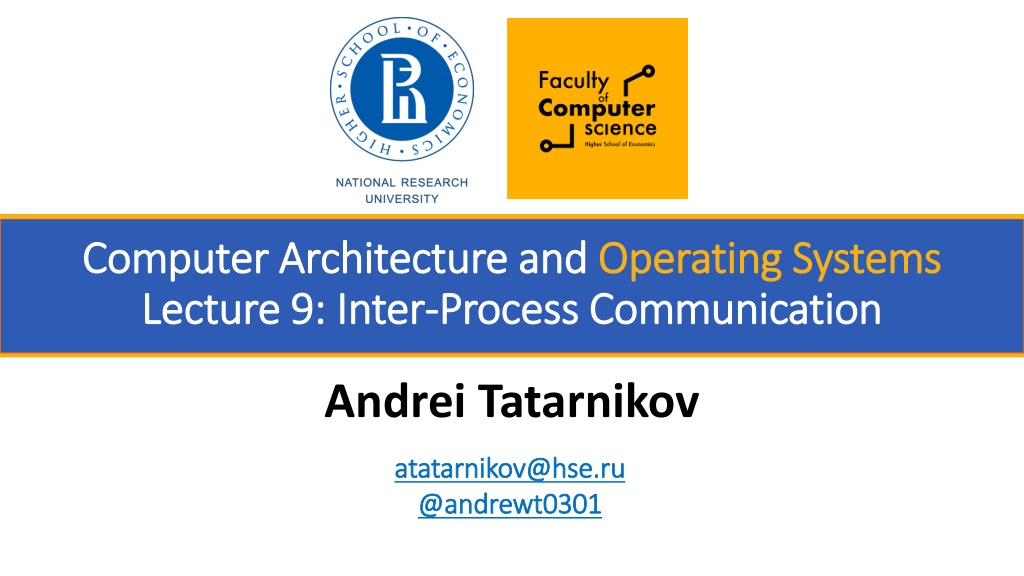

![❤Book⚡[PDF]✔ The Apollo Guidance Computer: Architecture and Operation (Springer](/thumb/21611/book-pdf-the-apollo-guidance-computer-architecture-and-operation-springer.jpg)







